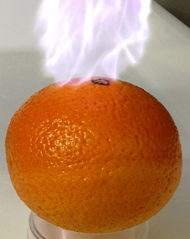
Plasma treatment: a potential tool to manage postharvest rots and food safety

Figure 1: Fruit inoculated with fungal spores undergoing plasma treatment.


Figure 2: Inhibited growth and proliferation of blue mould (above) and green mould (below) on the fruit surface.
Dr SP Singh, Research Horticulturist – Food Safety, Centre of Excellence for Market Access, NSW DPI
The future lies with postharvest treatments aimed to control fungal rots and human pathogens with zero chemical residues on the fruit. Cold plasma is the latest promising technology that might enter into packing houses to achieve cold pasteurisation of fruit. The technology is in nascent stage and has potential applications in the citrus industry.
Figure 1: Fruit inoculated with fungal spores undergoing plasma treatment.
Plasma is formed by the ionisation of gases and consists of reactive oxidising ions, electrons, free radicals, ozone and ultra-violet radiation. Recent technology that allows cold plasma generation without excessive heat has opened new applications for disinfecting and disinfesting fruits and vegetables.
Overseas research has shown that a short cold plasma treatment (3–120 seconds) is effective in killing/inactivating foodborne human pathogens such as Salmonella spp., Listeria monocytogenes, Escherichia coli O157:H7, and human noroviruses. Insects and pests (e.g. citrus mealy bugs, green peach aphids, western flower thrips and two-spotted mite) and plant pathogens have been killed using cold plasma treatment.
This technology offers several advantages in terms of operations at room temperature and pressure conditions, dry treatment, short treatment time and, best of all, no residues.
Figure 2: Inhibited growth and proliferation of blue mould (A) and green mould (B) on the fruit surface
Fungal rots caused by blue (Penicillium italicum) and green (P. digitatum) mould are a continuing postharvest problem for the citrus industry. Consumer and regulator demand for zero residues and developing resistance to postharvest fungicides are the drivers for finding alternatives to controlling these pathogens without compromising food safety.
A preliminary experiment at NSW DPI was conducted to explore the possibility of using plasma to control fungal rots caused by blue and green moulds in oranges. The fruit were injured and inoculated with blue and green mould, and then subjected to plasma treatment for 30 seconds (Figure 1).
The untreated inoculated (control) and plasma-treated inoculated fruit were kept at ambient conditions for five days.
Figure 2 shows the effect of plasma treatment on the suppression of fungal growth on fruit surface. The results are encouraging and further research trials on plasma application in controlling fungal pathogens in citrus are required.
The NSW DPI post harvest team at Ourimbah are ready (pending industry priority and funding) to conduct further work to refine this technology for commercial application in Australian citrus.
The team can also undertake disinfestation trials for significant quarantine pests such as fuller's rose weevil, mealybug and red scale.
More information
- Email: sp.singh@dpi.nsw.gov.au
- Phone: 02 4348 1935

